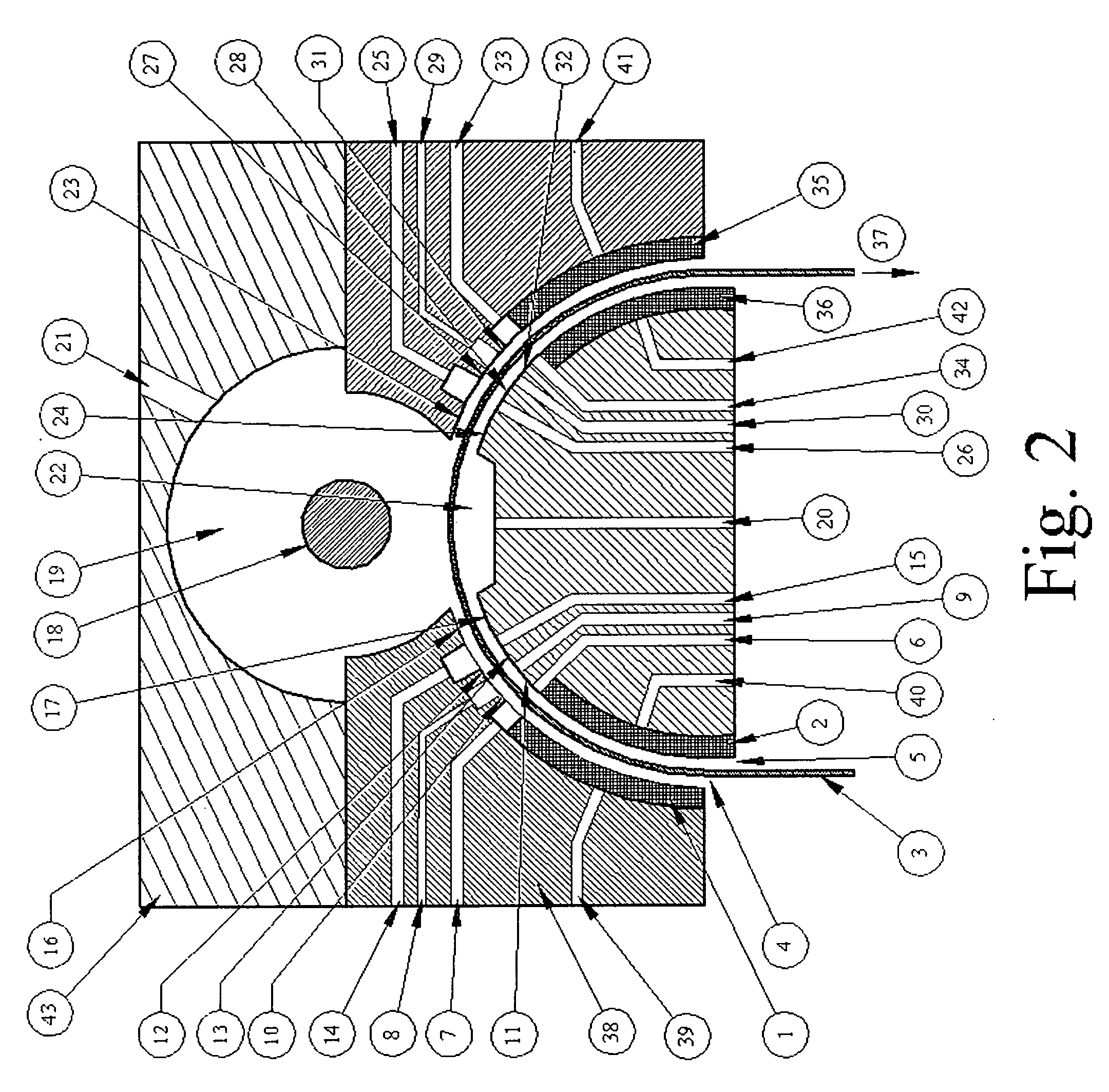[0013] An object of the present invention is to provide a method and apparatus for coating and baking FPD glass and semi-conductor substrates having a thin thickness and semi-uniform surface contained within an apparatus that allows for in-line processing and or controlled mini-environments for especially large panels in a substantially low pressure, or near perfect vacuum environment which greatly aides in the cleanliness, and non-contamination via
particulates in the process of coating and baking said substrates.
[0016] Through the use of successive differentially pumped grooves, axially placed relative to the substrate travel, a vacuum environment is created, as described in U.S. Pat. No. 6,515,288 Ryding, et al. enclosed herein as a reference, successive grooves are employed, leading to a chamber created by adding a larger cutaway in which a substantially lower pressure near vacuum is encapsulated and drawn down with external pumping means. This chamber allows an evaporative
chemical vapor deposition (CVD) or
plasma vapor deposition (PVD) process to be performed. The CVD / PVD process can be adjusted in order to deposit the desired thickness on the glass, or substrate. By heating the desired coating material, a type of gas is created, which causes particulate from the CVD / PVD process to condense on all surfaces within the chamber, including the desired substrate. Since there is a near perfect vacuum, there is no contamination via
particulates or unwanted materials. The speed with which the substrate is moved through the apparatus can also be modulated in order to control the thickness. As the
deposition process occurs, the substrate moves through the same number of differentially pumped grooves, only this time in increasingly higher levels of pressure, mirroring the initial series of grooves in reverse. In this way, a type of
vacuum chamber is created within the middle of the process, insuring that outside
ambient air is unable to penetrate, and appropriate vacuum pressures are reached as is required by the CVD / PVD process.
[0018] In yet a further embodiment of the described invention, a method can be integrated into the above described processes where the air supplied to the aerostatic bearings is temperature-controlled in preparation for a coating supplied by an axial slit type applicator. The
aerostatic bearing on the top surface of the substrate is configured with numerous evenly placed holes along grooves longitudinally along the bearings, in the direction of the substrate processing direction. The holes supply a vacuum force which is substantially greater than the weight of the substrate, effectively pulling the glass against the
aerostatic bearing lands for a precise gap between the bearing and the substrate. This enables the substrate to be introduced to the slit coater with micron level precision in the distance to the slit coater. This distance from the substrate to the coating orifice is important with certain types of coatings and insures an accurate thickness layer is applied. After the coating head, there are no longer any vacuum grooves in the
aerostatic bearing which is holding the glass up against it; in fact the preferred embodiment is to have nothing near the substrate coating, so effectively a space is created within the apparatus, allowing the substrate coating to dry. The substrate is transported by a lower aerostatic bearing which supports the substrate as it is “handed off” from the upper aerostatic bearing, through the coater, then to be supported by the lower aerostatic bearing. This allows the coating to dry properly as well as avoid transcription effects which can occur should there be any temperature variations on the surface of the substrate during and after the coating process. The apparatus could then conceivably incorporate various
drying and baking or further
etching elements in order to enhance the coating performance.
[0021] The
high heat source can, as described above, be situated on both sides of the substrate—above and below, and can be of numerous different means, as described immediately above. The simultaneous processing of both sides of the substrate in a non-contact nature of disposition is of great importance in some applications, and seen a major benefit of the invention, as well as the ability to perform
rapid thermal processing and annealing.
[0023] Within the manufacturing arena, floor space of machinery used to process the FPD sheets or substrates within a clean room environment is costly due to the necessary processes required in maintaining such an environment. Any way to minimize the amount of floor space required is advantageous. For this reason, a further aspect of the apparatus is the inline coordination and inclusion of each element described above, the resulting savings in floor space within the clean room environment is substantial thereby realizing a large
cost savings. Also the process is internal to the apparatus realizing significant benefits for the prevention of contamination of the clean room from any attendant aspects of any of the processes, as each stage can be performed on the substrate immediately after the previous one, insuring no contamination of the substrate passing from one operation to another.
[0024] Prior to this invention each step is performed separately, within the particular process's own arena on the
manufacturing line, thereby requiring significant floor space and the attendant conveyance equipment required to safely transport the substrate between the manufacturing processes. A further aspect of the preferred embodiment entails the processing of substrates and especially large substrates in processes as described above but in an immediately sequential fashion. This includes individually sequential ordering but also is to include simultaneous processing, so that a substrate conceivably could have any number of processes being performed at once, which is especially useful for web type substrates. Such improvements are perceived by its inventor as a significant enhancement in a growing industry which can potentially realize large
cost savings while improving overall processes parameters at the same time.
 Login to View More
Login to View More 


